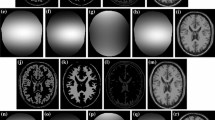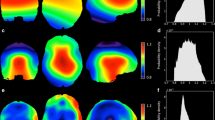Abstract
Intensity inhomogeneity is a smooth intensity change inside originally homogeneous regions. Filter-based inhomogeneity correction methods have been commonly used in literatures. However, there are few literatures which compare effectiveness of these methods for inhomogeneity correction. In this paper, a new filter-based inhomogeneity correction method is proposed and the effectiveness of the proposed method and other filter-based inhomogeneity correction methods are compared. The methods with different kernel sizes are applied on MRI brain images and the quality of inhomogeneity correction of different methods are compared quantitatively. Experimental results show the proposed method in a kernel size of 20 * 20 performs almost better than or equal the performance of other methods in all kernel sizes.
Similar content being viewed by others
References
Andersen AH, Zhang Z, Avison MJ, Gash DM (2002) Automated segmentation of multispectral brain MR images. J Neurosci Meth 122: 13–23
Ardizzone E, Pirrone R, Gambino O (2005) Exponential entropy driven HUM on knee MR images, Conf. (EMB), Shanghai, China, September 1–4
Balafar MA et al. (2008a) Medical image segmentation using anisotropic filter, user interaction and fuzzy C-Mean (FCM), Communications in Computer and Information Science, Springer, pp 169–176
Balafar MA et al. (2008b) Medical image segmentation using fuzzy C-Mean (FCM), learning vector quantization (LVQ) and user interaction, Communications in Computer and Information Science, Springer, pp 177–184
Balafar MA et al. (2008c) Medical image segmentation using fuzzy C-mean (FCM) and dominant grey levels of image. In: Visual information engineering conference, pp 314–317
Balafar MA et al. (2008d) Medical image segmentation using fuzzy C-mean (FCM), Bayesian method and user interaction. In: International conference on wavelet analysis and pattern recognition, pp 68–73
Balafar MA et al. (2008e) New multi-scale medical image segmentation based on fuzzy c-mean (FCM). In: IEEE conference on innovative technologies in intelligent systems and industrial applications, pp 66-70
Balafar MA et al. (2008f) MRI segmentation of medical images using FCM with initialized class centers via genetic algorithm. In: International symposium on information technology. pp 1–4
Balafar MA et al. (2010a) Review of brain MRI image segmentation methods, Artif Intell Rev. 33:261–274
Balafar M et al. (2010b) MEDICAL IMAGE SEGMENTATION USING FUZZY C-MEAN (FCM) AND USER SPECIFIED DATA. J Circuts Syst Comput 19:1–14
Balafar M et al. (2010c) IMPROVED FAST FUZZY C-MEAN AND ITS APPLICATION IN MEDICAL IMAGE SEGMENTATION. J Circuts Syst Comput 19:203–214
Balafar MA et al. (2010d) Edge-preserving Clustering Algorithms and Their Application for MRI Image Segmentation. IMECS 17-19
Balafar MA et al. (2010e) Compare different spatial based Fuzzy C-Mean (FCM) extensions for MRI Image Segmentation. ICCAE 609-611
Bansal R, Staib LH, Peterson BS (2004) Correcting nonuniformities in MRI intensities using entropy minimization based on an elastic model. Presented at the Medical Image Computing and Computer-Assisted Intervention (MICCAI 2004), Saint-Malo, France, pp 78–86
BrainWeb [Online]. Available: www.bic.mni.mcgill.ca/brainweb/
Brey WW, Narayana PA (1988) Correction for intensity falloff in surface coil magnetic resonance imaging. Med Phys 15: 241–245
Brinkmann BH, Manduca A, Robb RA (1998) Optimized homomorphic un-sharp masking for MR greyscale inhomogeneity correction. IEEE Trans Med Imaging 17(2) April, pp 161–171
Delibas̆ić B (2009) Reusable components for partitioning clustering algorithms. Artif Intell Rev 32(1–4): 59–75
Fernández F et al (2008) Nearest prototype classification of noisy data. Artif Intell Rev 30(1–4): 53–66
Gispert JD, Reig S, Pascau J, Vaquero JJ, Garcia-Barreno P, Desco M (2004) Method for bias field correction of brain T1-weighted magnetic resonance images minimizing segmentation error. Hum Brain Mapp 22: 133–144
Guillemaud R, Brady M (1997) Estimating the bias field of MR images. IEEE Trans Med Imaging 16(3): 238–251
Haselgrove J, Prammer M (1986) An algorithm for compensating of surface-coil images for sensitivity of the surface coil. Magn Reson Imag 4: 469–472
Koivula A, Alakuijala J, Tervonen O (1999) Image feature based automatic correction of low-frequency spatial intensity variations in MR images. Magn Reson Imag 15: 1167–1175
Lai SH, Fang M (1999) A new variational shape-from-orientation approach to correcting intensity inhomogeneities in magnetic resonance images. Med Image Anal 3: 409–424
Learned-Miller EG, Ahammad P (2004) Joint MRI bias removal using entropy minimization across images. Presented at the Neural Information Processing Systems Conferences (NIPS), Vancouver, Canada, pp 761–768
Likar B, Viergever MA, Pernu¡s F (2001) Retrospective correction of MR intensity inhomogeneity by information minimization. IEEE Trans Med Imag 20(12): 1398–1410
Lorena AC et al (2008) A review of the combination of binary classifiers in multiclass problems. Artif Intell Rev 30(1-4): 19–37
Mangin J-F (2000) Entropy minimization for automatic correction of intensity nonuniformity. Presented at the IEEE Workshop Math. Methods Biomed. Image Anal., Hilton Head Island, SC, pp. 162–169
Meyer CR, Bland PH, Pipe J (1995) Retrospective correction of intensity inhomogeneities in MRI. IEEE Trans Med Imag 14(1): 36–41
Smail Linda (2009) De-separation and computation of probability distribution in Bayesian networks. Artif Intell Rev 31(1-4): 87–99
Solanas E, Thiran JP (2001) Exploiting voxel correlation for automated MRI bias field correction by conditional entropy minimization. Presented at the 4th International Medical Image Computing Computer-Assist. Intervent. (MICCAI 2001), Utrecht, The Netherlands pp. 1220–1221
Vovk U, Pernu¡s F, Likar B (2004) MRI intensity inhomogeneity correction by combining intensity and spatial information. Phys Med Biol 49: 4119–4133
Vovk U, Pernu¡s F, Likar B (2007) A Review of methods for correction of intensity inhomogeneity in MRI. IEEE Trans Med Imaging 26(3): 405–421
Zijdenbos A, Dawant B (1994) Brain segmentation and white matter lesion detection in MR images. Critical Rev Biomed Eng 22(5-6): 401–465
Author information
Authors and Affiliations
Corresponding author
Rights and permissions
About this article
Cite this article
Balafar, M.A., Ramli, A.R. & Mashohor, S. A new method for MR grayscale inhomogeneity correction. Artif Intell Rev 34, 195–204 (2010). https://doi.org/10.1007/s10462-010-9169-7
Published:
Issue Date:
DOI: https://doi.org/10.1007/s10462-010-9169-7




